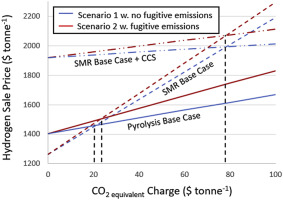International Journal of Hydrogen Energy ( IF 8.1 ) Pub Date : 2018-01-06 , DOI: 10.1016/j.ijhydene.2017.12.081 Brett Parkinson , Mojgan Tabatabaei , David C. Upham , Benjamin Ballinger , Chris Greig , Simon Smart , Eric McFarland

|
In the near-to-medium future, hydrogen production will continue to rely on reforming of widely available and relatively low-cost fossil resources. A techno-economic framework is described that compares the current best practice steam methane reforming (SMR) with potential pathways for low-CO2 hydrogen production; (i) Electrolysis coupled to sustainable renewable electricity sources; (ii) Reforming of hydrocarbons coupled with carbon capture and sequestration (CCS) and; (iii) Thermal dissociation of hydrocarbons into hydrogen and carbon (pyrolysis). For methane pyrolysis, a process based on a catalytic molten Ni-Bi alloy is described and used for comparative cost estimates. In the absence of a price on carbon, SMR has the lowest cost of hydrogen production. For low-CO2 hydrogen production, methane pyrolysis is significantly more economical than electrochemical-based processes using commercial renewable power sources. At a carbon price exceeding $21 t−1 CO2 equivalent, pyrolysis may represent the most cost-effective means of producing low-CO2 hydrogen and competes favorably to SMR with carbon capture and sequestration. The current cost disparity between renewable and fossil-based hydrogen production suggests that if hydrogen is to fulfil an expanding role in a low CO2 future, then large-scale production of hydrogen from methane pyrolysis is the most cost-effective means during the transition period while infrastructure and end-use applications are deployed.
中文翻译:

使用甲烷制氢:燃料和化学物质脱碳的技术经济学
在不久的将来,制氢将继续依靠改革广泛可用的且成本相对较低的化石资源。描述了一种技术经济框架,该框架将当前的最佳实践蒸汽甲烷重整(SMR)与低CO 2制氢的潜在途径进行了比较。(i)电解与可持续的可再生能源结合;(ii)与碳捕获和封存(CCS)相结合的碳氢化合物重整;以及 (iii)碳氢化合物热分解为氢和碳(热解)。对于甲烷热解,描述了一种基于催化熔融Ni-Bi合金的工艺并将其用于比较成本估算。在没有碳价的情况下,SMR的制氢成本最低。低CO 2制氢,甲烷热解比使用商业可再生电源的基于电化学的过程经济得多。在碳价超过$ 21 t -1 CO 2当量的情况下,热解可能代表生产低CO 2氢的最具成本效益的方式,并在碳捕获和封存方面与SMR竞争激烈。当前可再生能源与化石能源制氢之间的成本差异表明,如果氢气要在低CO 2未来中发挥更大的作用,那么甲烷热解大规模生产氢气是过渡期间最经济高效的手段部署基础架构和最终用途的应用程序。











































 京公网安备 11010802027423号
京公网安备 11010802027423号